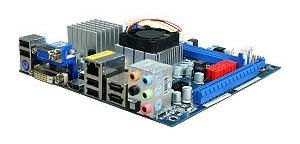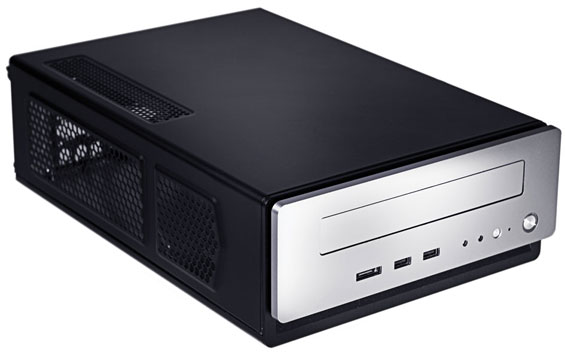Nettop and Mini-ITX Buyer’s Guide
by Zach Throckmorton on April 22, 2011 2:00 PM ESTIntel Upgraded HTPC Nettop
| Intel Upgraded HTPC Nettop | ||
| Component | Product Name | Price |
| CPU + Mobo | ASRock A330ION (Atom 330 + NVIDIA ION) | $120 |
| Memory | Patriot 4GB (2x2GB) PSD34G1333K | $40 |
| Case + PSU | Antec ISK310-150 Black/Silver + 150W PSU | $80 |
| Storage | Samsung SpinPoint MP4 HM640JJ 640GB 7200RPM 16MB | $60 |
| Optical Drive | Sony Optiarc BC-5500H-01 BR-ROM/DVD-ROM | $90 |
| Operating System | Windows 7 Home Premium 64-bit | $100 |
| Extra Software | CyberLink PowerDVD 11 Ultra | $100 |
| Total Price | $590 | |
For our upgraded configurations, we’re going to look into making something that’s a bit more capable as an HTPC. On the Atom side, the only way you can do that is if you get a better GPU than the 3150, and the easiest (and cheapest) way to do that is to purchase an ION motherboard. With the arrival of AMD’s Brazos, most motherboard manufacturers are shifting to that platform. It certainly doesn’t help that when Intel moved from the original Atom platform to Pine Trail, they integrated the Northbridge into the CPU package and  essentially killed off the ION chipset, so now you’d have to get a Pine Trail board with a PCIe slot if you wanted a discrete GPU. The result of all this is that we’re sticking with the older Atom 330 + ION for our upgraded Intel configuration, which is not without drawbacks.
essentially killed off the ION chipset, so now you’d have to get a Pine Trail board with a PCIe slot if you wanted a discrete GPU. The result of all this is that we’re sticking with the older Atom 330 + ION for our upgraded Intel configuration, which is not without drawbacks.
For this setup, we’ve selected the ASRock A330ION board, but availability and pricing can be a little sketchy on any of these older ION boards. As one of the major flaws with the Atom platform was its inability to play HD video smoothly, NVIDIA used their ION (a rebadged 9400M chipset) to address this issue. Paired with the dual-core Atom 330 CPU, this platform can play HD videos and even Blu-ray content—though not 3D Blu-ray. The ASRock board also has VGA, DVI, and HDMI ports. We first looked at the ION platform almost two years ago, and you can still get a good idea of its capabilities and limitations from our original assessment. For the memory, we’re again using desktop DIMMs, but now we’re upgrading to 4GB (2x2GB) of Patriot memory. The basic desktop DDR3 kits seem to have bottomed out at around $40 shipped without rebates. 2GB is sufficient, but the $18 extra can provide more headroom for multitasking.

The remaining components once again depend on the case selection, and we’ve selected the upgraded Antec ISK310-150 this time. We like this case a lot because it comes with a reasonably quiet 80mm fan, typical minimalist Antec aesthetics, and uses an external power adapter (which makes no noise, and is more efficient than internal power supplies—especially considering these low-powered nettops draw at most 25-30% of even a low wattage 150W PSU). It’s also available with a black bezel if you prefer that to the silver bezel. As with the ISK 100, this case uses 2.5” laptop hard drives, not 3.5” desktop hard drives. We’re only using one HDD again, but this case can fit two drives so SSD + storage drive is again an option.
For the hard drive, we’re going to offer an alternative to the 500GB Seagate that has seen so much use in laptops during the past year. Samsung recently launched their 640GB 7200RPM SpinPoint MP4 HM640JJ, at the same $60 price point as the Seagate. The higher areal density should improve sequential transfer speeds, and it will certainly be faster than the 5400RPM laptop drives. For the optical drive, you could stick with the same Samsung mentioned in the basic Intel configuration, but our upgraded nettops are going to take more of an HTPC role so we’re going the Blu-ray route. Slim BD-ROMs are difficult to find for less than $100, and in fact this is the only slim BD-ROM Newegg currently stocks. Note that it’s a DVD-ROM as well, so there are no burning capabilities to speak of—we suggest you use a different system for burning, and particularly video encoding/transcoding as such tasks can be painfully slow on Atom.
If you’re going to watch Blu-ray movies, you’ll also need appropriate software. The software included with the Sony drive is underwhelming, and CyberLink’s PowerDVD Ultra tends to work well with a variety of platforms. It also happens to cost $100, so you might want to start with the basic Blu-ray software and only upgrade if you want access to other features.
With all of the upgrades and a copy of PowerDVD, the total system cost is nearly double that of the base Atom setup, though much of that comes from choosing to include Blu-ray support. $590 is a lot to pay for an Atom nettop, certainly, and we’ll discuss other options in our conclusion. If you want to skip out on Blu-ray playback, you can get the above system for $400. Using the same case and components, the difference in motherboard choice makes this platform $10 more than the basic AMD E-350 setup, or $37 more than the stock Atom configuration.










101 Comments
View All Comments
7Enigma - Monday, April 25, 2011 - link
Glad someone else pointed this out because this is exactly what I'm currently using on my desktop system connected to my bedroom TV. Work perfectly.Holly - Friday, April 22, 2011 - link
Although getting a decent soundcard increases the cost of the machine a lot I am suprised and disappointed there was no proper sound card in any of setups. Frankly I have had lots of various mobos with integrated sound and have yet to find one that doesn't get left in dust when you compare with decent sound card... ofc, that's the case when you are not using $20 plastic speakers for your home theatre.numbertheo - Friday, April 22, 2011 - link
Except for the budget Atom system, all of these setups have some kind of digital audio output. I would suspect that most home theaters have some kind of receiver, AV processor, or DAC already present. In my opinion, people willing to set up a full blown home theater have better options that a sound card.On the other hand, a test of the integrated audio would be nice since I have had problems with it in the past.
haukionkannel - Friday, April 22, 2011 - link
As numbertheo said, external DAC or similar system is most propably better alternative than sound card in these system. Arcam rDAC or something similar offer allmost hifi guality... ofcource they cost near 300$ so they allmost douple the prize of these systems...UrQuan3 - Tuesday, April 26, 2011 - link
I'll second the request for soundcard testing.I've had trouble finding a *receiver* for much under $1000 that has a good D/A converter. On the other hand, a $100 soundcard outputing 5.1 analog to a $250 receiver often does very well. Much better than the same class of receiver using SPDIF.
This surprised me, but it's very true.
LeTiger - Friday, April 22, 2011 - link
I've been using since last JanuaryZotac Atom/Ion A-U $179
Crucial 2gb DDR2-800 $55
OCZ 30gb Agility $109 (boot drive)
WD 1tb Green $55
Samsung 750gb spinpoint $45
Dangerden Tower $99
Total: $542
Works like charm. (unless you have an addiction to Photoshop)
Aikouka - Friday, April 22, 2011 - link
Hi Zach,About your last configuration... are you sure that the heatsink will fit properly? I have the same case with a Clarksdale build, and I actually ended up using Thermaltake's Slim X3 HSF ( http://www.newegg.com/Product/Product.aspx?Item=N8... ). The thing is, even with the X3, there's barely any room between the PSU and the HSF.
What about using a PicoPSU instead? I haven't personally ever used one, but it should give room for significantly more airflow. The 35W TDP CPU should certainly help as well.
The PSU in the ElementQ also has a very long ATX connector cable... it's actually too long in my opinion!
JarredWalton - Saturday, April 23, 2011 - link
The stock HSF on the 2100T is very low profile, so it should work well. Other SNB CPUs might not fit without a different cooler. As for a PicoPSU, I don't think you'd want to do that with the Element case, simply because it already has the space for an SFX PSU. You'd end up with a big hole on the back. In other cases, though, it might be worth trying.Aikouka - Saturday, April 23, 2011 - link
I do agree that it is definitely low-profile. I am actually just finishing a build with an i3 2100T right now, and I pulled down my i5 2500k box to compare the HSF. I didn't even notice that there was a difference since I've never seen the stock HSF :P.The "big hole" is the reason why I haven't tried it yet, but I am assuming that someone has to make a "cover" for it that you can attach the plug to.
My i3 HTPC (it's an i5-540) does run a little bit hot, but it's not a 35W TDP unit... I believe it's 70-something. I have read a few comments of people putting a fan in the side of the Element Q case to help with airflow as well.
StardogChampion - Tuesday, May 10, 2011 - link
"You'd end up with a big hole on the back."I make/sell backplates in the ATX and SFX12V form factor to plug that hole. They can have mounts for either type of picoPSU jack and for the ATX and 80mm case fan and the SFX12V a 60mm fan.